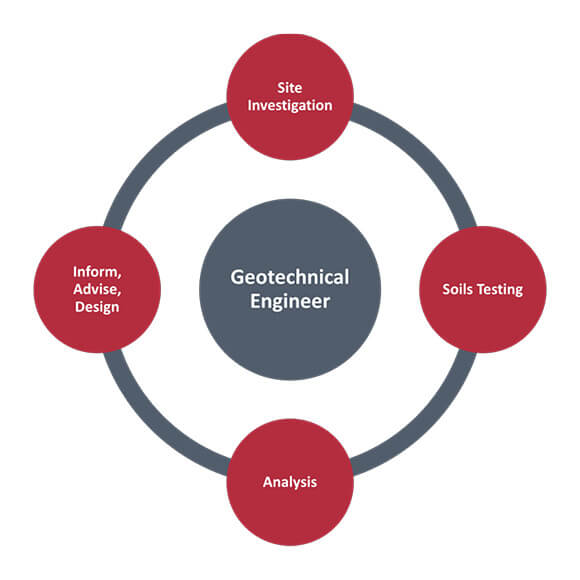The 10-Minute Rule for Geotheta
The 10-Minute Rule for Geotheta
Blog Article
The Of Geotheta
Table of ContentsAbout GeothetaNot known Factual Statements About Geotheta How Geotheta can Save You Time, Stress, and Money.The 5-Minute Rule for GeothetaGeotheta - Truths

They conduct website examinations, accumulate examples, perform research laboratory examinations, and analyze information to examine the suitability of the ground for building and construction jobs - Consulting Engineers. Based on their findings, geotechnical engineers offer suggestions for structure layout, slope security, maintaining structures, and reduction of geotechnical risks. They collaborate with other specialists, such as designers, structural engineers, and construction groups, to make certain that geotechnical considerations are incorporated right into the general project design and execution
By analyzing the behavior and homes of soil and rock, they can identify potential geotechnical hazards such as landslides, dirt negotiation, or incline instability. Their experience aids stop failings or accidents that can jeopardize lives and property. Below are some thorough obligations and obligations of a geotechnical designer: Site Examination: Geotechnical designers conduct site investigations to collect information on subsurface conditions.
They interpret the data to comprehend the buildings and actions of the dirt and rock, including their toughness, permeability, compaction characteristics, and groundwater conditions. Geotechnical Evaluation and Layout: Geotechnical designers assess the information accumulated throughout website examinations to examine the security and viability of the site for building jobs. They do geotechnical computations and modeling to examine aspects such as bearing capacity, settlement, incline security, lateral earth pressures, and groundwater circulation.
Geotheta Things To Know Before You Get This
Structure Design: Geotechnical designers play an essential function in designing structures that can securely support the desired structure. They assess the dirt conditions and lots requirements to figure out the suitable structure type, such as superficial foundations (e.g., footings), deep structures (e.g (https://yoomark.com/content/httpsgeothetacom)., heaps), or specialized techniques like dirt enhancement. They think about aspects such as settlement limits, bearing ability, and soil-structure interaction to establish optimal structure styles
They evaluate construction strategies, screen site tasks, and carry out field examinations to validate that the style recommendations are adhered to. If unanticipated geotechnical problems arise, they analyze the situation and supply recommendations for removal or modifications to the design. Danger Analysis and Mitigation: Geotechnical designers assess geotechnical risks and risks connected with the project site, such as landslides, liquefaction, or dirt erosion.

Collaboration and Interaction: Geotechnical designers work carefully with various other experts entailed in a project, such as architects, structural designers, and building teams. Efficient interaction and cooperation are necessary to integrate geotechnical considerations right into the overall job design and building and construction procedure. Geotechnical designers supply technical know-how, answer inquiries, and make sure that geotechnical requirements are satisfied.
Geotheta Fundamentals Explained
Below are some kinds of geotechnical designers: Structure Designer: Structure designers focus on developing and evaluating structures for frameworks. They assess the soil conditions, tons needs, and website qualities to establish one of the most appropriate foundation type and style, such as shallow structures, deep foundations, or specialized techniques like pile foundations.
They assess the elements influencing slope stability, such as soil homes, groundwater conditions, and slope geometry, and establish techniques to stop incline failings and alleviate dangers. Quake Designer: Earthquake engineers specialize in evaluating and developing structures to endure seismic forces. They evaluate the seismic hazard of a site, evaluate dirt liquefaction possibility, and establish seismic design criteria to ensure the safety and resilience of frameworks throughout earthquakes.
They carry out field testing, accumulate examples, and examine the gathered data to characterize the dirt properties, geologic developments, and groundwater conditions at a site. Geotechnical Instrumentation Designer: Geotechnical instrumentation designers focus on surveillance and gauging the habits of soil, rock, and frameworks. They set up and maintain instrumentation systems that check variables such as soil settlement, groundwater degrees, slope activities, and structural variations to examine efficiency and supply early warnings of possible issues.
Geotheta Can Be Fun For Everyone
They perform tests such as triaxial examinations, debt consolidation examinations, direct shear examinations, and leaks in the structure examinations to gather data for geotechnical evaluation and design. Geosynthetics Engineer: Geosynthetics designers specialize in the style and application of geosynthetic products, such as geotextiles, geogrids, and geomembranes. They use these materials to enhance dirt security, reinforce inclines, provide drain remedies, and control erosion.
They tend to be investigative people, which implies they're intellectual, reflective, and analytical. They are interested, systematic, reasonable, logical, and rational. Some of them are likewise social, indicating they're kind, generous, cooperative, patient, caring, useful, compassionate, tactful, and pleasant - Consulting Engineer.
In the workplace atmosphere, geotechnical designers use specialized software application tools to perform calculations, create styles, and evaluate data. They prepare records, evaluation job specifications, communicate with customers and staff member, and coordinate task activities. The office setup supplies a conducive environment for research study, analysis, and cooperation with various other experts included in the project.
The 7-Minute Rule for Geotheta
They regularly check out task sites to perform site examinations, evaluate geotechnical problems, and collect information for evaluation. These gos to entail traveling to different areas, in some cases in remote or tough surfaces. Geotechnical engineers may execute soil sampling, conduct examinations, and display construction tasks to ensure that the geotechnical elements of the job are being implemented properly.
Geotechnical designers likewise function in specialized geotechnical laboratories. In these facilities, they carry out experiments, execute tests on helpful site soil and rock samples, and assess the design homes of the products. Geotechnical research laboratory engineers work extensively in these atmospheres, taking care of screening equipment, operating instruments, and taping information. They team up with other lab team to make sure exact and reliable testing results.
Report this page